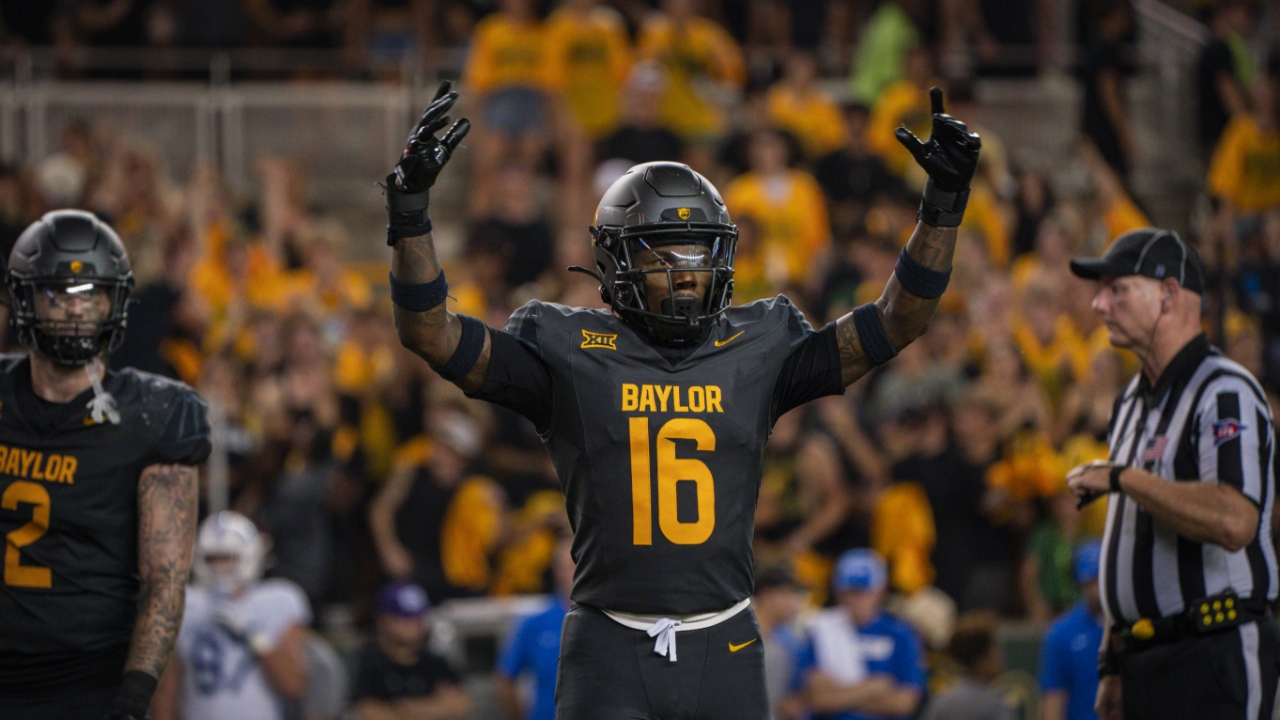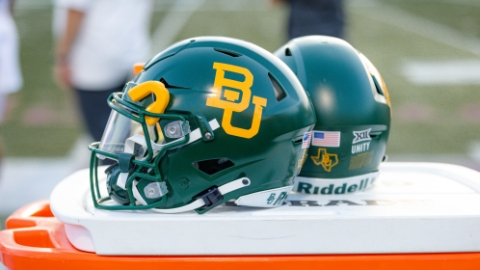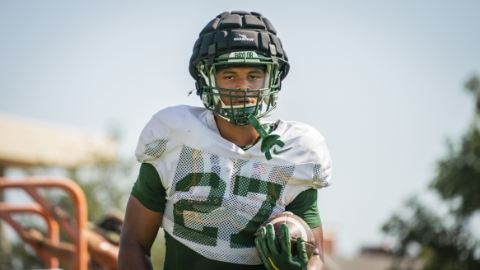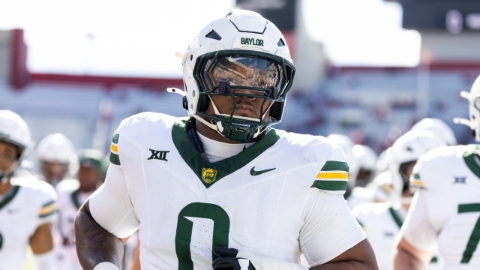Second Chances and Silent Struggles: The Unseen Battle & Comeback of Kendrick Simpkins

New Members: Subscribe to 3 Months of SicEm365 Premium for $5
Leading by a field goal with just under three minutes remaining in the first quarter of the prime-time, under-the-lights matchup between the Bears and Buffs at Folsom Field on Sept. 21, Baylor fifth-year senior safety Kendrick Simpkins started to ever-so-slightly creep toward the line of scrimmage on a second and long with the play-clock dwindling toward double zeroes.
When Colorado's star signal caller, Shedeur Sanders, hiked the ball and dropped back to pass, Simpkins came screaming off the right edge, as if he were shot out of a cannon and lit up Sanders' blindside, who, milliseconds before, released the football and was able to find his tight end for a five-yard gain.
Despite putting Sanders in the dirt, Simpkins instantly felt something amiss and limped off the field with a sharp pain in his upper-right leg. Heating pads, pain medicine and Icy Hot didn't do the trick, forcing Simpkins to fear the worst and dreadfully watch the rest of the 38-31 overtime loss to Colorado from the sidelines.
A couple of weeks later, Simpkins learned that he had torn his right quadricep, which would keep him out for the rest of the regular season.
Simpkins found himself spiraling, feeling the weight of not being able to play. He had told himself he didn't deliver his end of the bargain to a coaching staff that made an investment in him after prioritizing him as a transfer portal pick-up from Western Kentucky last offseason.
He also didn't know whether his body would heal correctly or whether he'd get an extra season of eligibility. If he did get another year, would the coaching staff want him back, or would he have to pack his bags and find a new home? Not to mention that his NFL aspirations potentially went down the drain as well.
"It was probably the hardest thing in my life, especially in my college career because it was my first big injury," Simpkins said in a sit-down interview with SicEm365. "That was my first time away from football because even in my freshman year, I didn't redshirt."
He continued, "It was a really tough time; I had to reach out to some mentors, and I had to do a lot of therapy sessions because it took a big toll on me. Knowing that they paid me to come here and that the format has changed — a lot of different things were going through my head."
When Simpkins was able to spend some time with his teammates away from the practice field, he continued to crack jokes like he always did, but he felt in limbo on the inside.
"I was still trying to be a leader, and I didn't want my downness to get over the team or get over some players," Simpkins said. "When I was talking to them, it really wasn't even about me. A lot of them probably don't know that I had to go through it like I did. I was trying to make them laugh and play as much as I could to get my mind off it. Every time I was around my teammates, it warmed me up — I didn't want to leave. I knew once I got home, I was going to think about [my injury] again."
Simpkins, no stranger to struggle throughout his life, was raised as an only child in a single-parent household for most of his youth in Montgomery, Alabama.
"My childhood wasn't the greatest, but it wasn't the worst either; sometimes you might want your dad, like if you see somebody playing in the yard or taking them somewhere, it could be a little sad," Simpkins said. "But seeing my mom and the way she made things work, and the structure she had, I'm the person I am today because of my mom."
Although he's extremely close with his mother, Adonica Heard, and still talks to her daily, Simpkins often yearned for a father figure to lean on when he started to take football and athletics more seriously as a teenager.
"Growing up and looking for that father figure was one of the bumps in the road," he said. "I wish I had somebody there with me for football. When I got into my teenage years, that started messing with me more. I wanted to find out more about football and talk to my father about it."
When high school rolled around, Simpkins established positive relationships with mentors and father-like figures in his community, such as his varsity football coach, Tyrone Rogers, a six-year veteran NFL defensive lineman.
"He had a huge impact on me," Simpkins said of Rogers. "Coming in as a freshman, your nose is snotty, and you're not really thinking about all of that. As you start growing up, like that transition to my junior year, you start to think that's for sure somebody I look up to. I don't have to be exactly like him, but I want to live my life the way he does with purpose. I want my process to be the same as his."
After spending a season as the fourth-string quarterback, Simpkins starred as a defensive back at Lee High School across the next three years and helped the Generals to a 7-3 record as a senior. He was a three-star prospect and the No. 43-ranked player in Alabama in the 2020 recruiting class.
Initially, Simpkins was choosing between Tennessee and Colorado, but Florida Atlantic made a resounding push, and he committed to Lane Kiffin, the head coach at the time, and the Owls.
When Kiffin left sunny Boca Raton for Ole Miss, Simpkins expected to re-route to Oxford, but the Rebels' 2020 recruiting class was completely full, leaving him stranded with a couple of weeks until National Signing Day.
It was too late in the recruiting process to circle back to Tennessee or Colorado, but Western Kentucky's head coach, Tyson Helton, had spent a season in Knoxville and heard of Simpkins through some mutual connections. Simpkins then took a last-minute official visit to Western Kentucky and committed to the Hilltoppers.
At the time, Simpkins was frustrated, to put it mildly, with the recruiting process, but in retrospect, he appreciates how things fell into order, saying, "Where I'm at now, I wouldn't change it one bit. Everything I've been through and experienced has helped me today."
During his four seasons at Western Kentucky, Simpkins played in 42 games with 22 starts and totaled 120 tackles. He had a breakout season in 2023, with 52 tackles, 11 for a loss, four forced fumbles and 7.5 sacks — the highest sack-total in the country by a defensive back.
"It was amazing," Simpkins said of his time with the Hilltoppers. "I would have never had those years if I didn't have good guys in the safety room as a freshman and sophomore. I had some guys older than me who really paved the way for me. It made me realize I could do the same for someone else because of their big impact on me. I love Western Kentucky. I still talk to people there all of the time and to some of my coaches."
Following his stellar 2023 campaign, Simpkins debated a return to Western Kentucky but ultimately decided to enter the transfer portal, desiring a landing spot where he could play at a higher level and on a bigger stage.
Simpkins also sought to play for a defensive-minded head coach and at a faith-based institution, which made Baylor the perfect landing spot when safeties coach Matthew Powledge started to recruit him.
"It was hard leaving; I didn't know it would hit me like that because I was going to miss the guys. I was so comfortable for four years, and I pretty much grew up there, "Simpkins said of Western Kentucky. "When I came to Baylor, it was open arms. If there weren't as many good people as there are here, then it probably would have been a harder transition, but everybody welcomed me with open arms."
Simpkins arrived in Waco with big expectations for himself: to be a disrupter on a rebuilding defense and a key piece on a winning team. When he was forced to miss most of the regular season with an injury, he had to reevaluate who he was as a person outside of football and started regularly attending counselling in an attempt to ease the mental stresses that resulted from his first significant injury.
"It was weird for me at first because I don't really open up to a lot of people with personal things, unless it's my family," Simpkins said. "Once I got those first few words out, it felt good, and that's what made me start coming back. After I went home, I had forgotten to say something and wanted to talk about more stuff. It wasn't the best starting off, but once we started going through it, it was smooth sailing, and it helped me out a lot."
He added, "The biggest thing I learned about myself is that I'm strong, but sometimes, if there are times when I'm not strong, it's okay. I had never gone to therapy or anything like that. The injury hit me hard, but it let me know that you can be strong and still go through things. That's part of adversity. We say we want adversity, but when a certain type of adversity hits, it's like, 'Oh. Why me?' I had those questions, but after it all, it made me a better person and player."
With Simpkins starting to feel more like himself toward the end of the fall, both physically and mentally, he was medically cleared to play in the Texas Bowl against LSU, where he recorded 16 snaps and collected a tackle.
"I probably shed some tears," Simpkins said of when he first found out he could play. "I had a nice, solid game. I still wasn't 100%, but it felt good to get back out there and just play with the guys. It was a great experience. I hate that we lost, and I wish we could have gotten that win."
After initially worrying that he might not be granted another season or whether he'd be able to stay at Baylor, Simpkins received a medical redshirt waiver when the offseason started and was told by the coaching staff that they wanted him to return for another year.
"I talked to Coach Aranda and Coach Powledge, and they wanted me back, and I wanted to come back," Simpkins said. "I wanted to prove to myself and the world and the fans after getting hurt, and the coaches felt the same energy. Even if they wanted me to move on, I would have respected their decision because they thought they'd only have me for a year, but they felt my impact, my leadership and my impact on the field would be big."
These days, things are looking up for Simpkins. He was a full participant in practices throughout the spring. He's expecting a baby girl with his fiancée, Kristyonna, later this fall, which he's extremely excited about, but hopes the arrival date doesn't fall on a Saturday. He's also been growing in his faith more recently than at any other point in his life.
"If I had to give a number, my faith probably went from a 15 to a 100," he said. "In my past life or my early life, maybe I was going by faith or leaning on my faith, but I wasn't physically aware of what I was doing. Since I've been at Baylor, faith is a word that's been brought up a lot, and I've grown tremendously in that aspect. That's helped me on this journey, and that's helped me change into the better man I am today."
As for his play on the field, the sixth-year senior is basking in every opportunity to be back, saying, "No. 1 goal is to continue to be a leader and make an impact in every way that I can, whether it's on the field, off the field, in the weight room or in the film room. No. 2 would be production. I need the production. The team needs the production. Fans want the production."
He continued, "I'm not taking anything for granted and am just appreciating every little thing I can and every person that I can. It can all be gone that fast, soaking in every little thing because this is my last, last spring. I'm trying to pick up where I left off and get back to that."
Spring Football Spotlight: Powledge's Safety Room Growing into Versatile, Veteran Force




